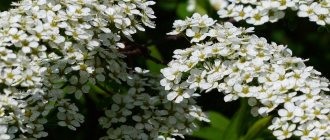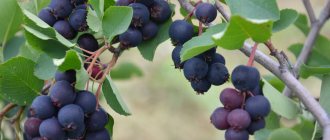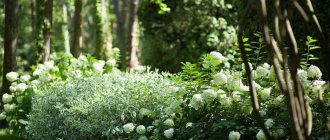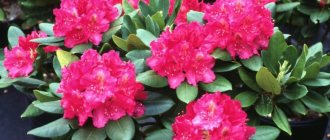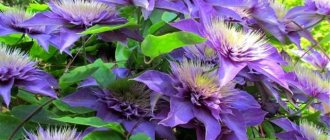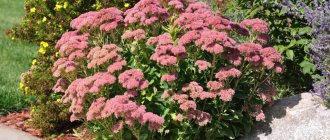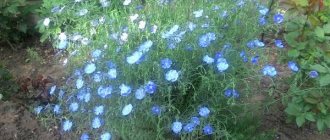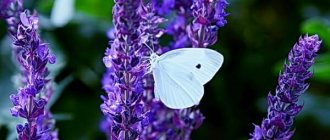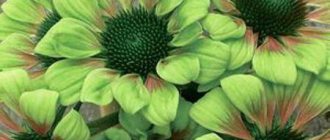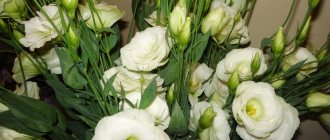The shrub Japanese spirea goldflame (golden flame, goldflame) is one of the most common and popular shrubs from the Rosaceae family. Spiraea goldflame came to us from Japan, hence its name - Japanese.
This fast-growing and long-flowering shrub is loved by many gardeners for its ease of care and its external beauty. Now this variety of shrub is widely used in landscape design, since, thanks to its characteristics, it can take root in almost any climate.
Let's figure out what kind of care Spiraea goldflame requires and what requirements exist for watering, planting and growing this luxurious shrub (see photo).
Description of the plant
Spiraea goldflame is a deciduous shrub with a height of sixty to eighty centimeters. Throughout the year, this plant changes the color of its foliage many times - from deep green to bright yellow, hence the telling name goldflame, which means “golden flame” in English.
The foliage itself is lush and uniform, which greatly attracts gardeners and landscape designers - such a shrub will look advantageous in any garden. During flowering, the leaves reach a rich light green hue, and the small flowers take on a pinkish-purple color. The leaves themselves have an elongated shape with sharp, tooth-like edges.
The color of the foliage also depends on the age of the shrub and the amount of sun hitting the foliage. Young Spiraea goldflame will take on an orange color, and with age the foliage will lighten to light yellow shades. Also, with an abundance of sun, the leaves of spirea goldflame will be bright, saturated colors, and with a lack of sunny color, they will be darker and more restrained.
Over the course of a year, the volume of the bush increases slightly, by only ten centimeters in diameter. Goldflame spirea blooms in the summer - from June to August - for fifty days. At this time, small pink flowers appear on the bushes, which gather in small inflorescences and emit a sweet, pleasant aroma.
A charming hybrid - Spiraea Boumalda
But it was not for nothing that the similarity of the Boumalda spirea with its Japanese counterpart was noticed. It is its hybrid in collaboration with the white-flowered spirea and has been found in cultivation much more often since 1890. It is quite difficult to distinguish it from Japanese spirea, especially some varieties. Basically, it is lower and has ribbed shoots.
It is also frost-resistant, but sheds its leaves. It grows quite slowly and is prone to drying out after 6-7 years of life, but in general, with light, moist soil, regular watering and annual spring pruning, it can live 15-20 years. Typically, it grows up to 75 cm in height with a neat spherical crown with erect branches.
By spring, 8 cm long, sharp, ovate-lanceolate leaves, doubly serrate along the edges, appear on them. And already in the summer, small lush flowers of romantic shades appear among the foliage: from pale pink to dark clove-raspberry and fall off only after 50 days. The color largely depends on the variety of spirea Boumalda:
- "Atrorosea" with reddish-brown leaves and dark pink flowers grows up to 1.4 m in height and tolerates shade and a northern location;
- 'Anthony Waterer' is slow growing with dark green leaves and ruby red flowers;
- "Crispa" is only up to 50 cm high with wavy-curling edges of wine-red leaves and dark purple flowers;
- 'Dart's Red', with crimson/ruby-red flowers, changes leaf color seasonally (pinkish in spring, dark green in summer and red in autumn) and is the most frost-hardy variety (up to 9b);
- "Froebelii" with pale pink inflorescences grows slowly;
- "Gold flame" has bronze-orange, later golden-yellow leaves and carmine-pink flowers.
READ MORE: Foundation depth: tips on choosing the main parameters and recommendations on how to choose the optimal depth (80 photo diagrams)
Spiraea varieties
Different varieties of spirea bloom at different times of the year, so if you wish, you can create a composition in the garden from different varieties of spirea so that the flowering of the shrubs continues almost the whole year. Spiraea varieties are divided into seasonal ones.
Spring varieties
- Spiraea nipponensis
- Spiraea Arguta
- Spiraea oakleaf
Summer varieties
- Spiraea goldflame
- Spiraea Boumalda
- Spiraea looseleaf
- Spiraea white-flowered
Landing
Spiraea goldflame loves the sun, therefore, when choosing a place to plant a shrub, you should give preference to an open area that will receive a lot of light. Without the sun, the spirea leaves will turn green, lose their decorative properties, and the plant will bloom sparingly.
The plant itself is unpretentious, but if you take into account all the few needs for the best flowering of the shrub, it will give maximum growth and beauty. The soil for planting should be chosen fertile, with moderate humidity, and there should be good drainage. If you plant spirea on acidic soil, this will affect the color of the foliage - it will be brighter, the color will reach purple.
Also note that spirea will produce basal shoots, so it will take up more space, therefore, it is worth taking into account the area and allocating more space for the shrub.
Since spirea is an undemanding plant, planting and growing it will not be difficult. When purchasing seedlings, pay attention to the roots - they must be moist. If they are dry, it means the plant is unhealthy and will not take root. Also look at the shoots - a healthy plant has mobile shoots with pronounced buds.
The hole for planting should be dug in advance, about two to four days before planting. The planting itself should be carried out not in sunny weather, but in cloudy or even rainy weather. Its size should be taken into account relative to the volume and diameter of the roots; the hole should be one and a half times the size of the roots.
Materials that can be purchased at a gardening store, as well as broken bricks, are suitable for drainage. The drainage layer is approximately twenty centimeters. The soil mixture should consist of a 3:2:1:1 ratio of turf soil, humus, peat and sand, respectively.
Carefully place the seedling in a hole prepared in advance, straighten the roots and sprinkle with soil mixture up to the root collar. When planting is complete, the seedling needs to be watered generously and small holes made in the soil to retain moisture.
Choosing a site and preparing for planting
Spirea loves a lot of light, but not the scorching rays of the sun. In constant shade, the leaves of the plant will not change color, it will be monochromatic and dull, and flowering will become scarce. Drafts and strong winds will not add beauty to this plant. The spirea bush will be adversely affected by the close flow of groundwater and stagnation of moisture in low-lying areas. The soil must be chosen fertile, loose, well-drained, with high acidity
The more acidic the soil, the brighter and more beautiful the foliage of the bush. If the soil in the selected area is depleted, then you need to dig it up with the addition of turf, humus, peat and sand. When choosing Goldflame spirea seedlings, you need to pay attention to the roots and branches. The roots should be well developed, moist and elastic or covered with a moistened earth ball.
Flexible and living branches should not have leaves, only buds.
It is better to plant Goldflame spirea in late autumn, after the end of leaf fall, or in early spring, when the buds have not yet appeared. It is advisable that the weather be cloudy and even rainy.
- The hole must be dug a few days before planting. Its width should be 1/3 greater than the volume of the roots.
- Before planting, the roots of the seedling are soaked in water for 20 minutes.
- Dried and damaged roots of the seedling are removed. The shoots are cut to 1/3 of their length.
- At the bottom of the pit, drainage is made from expanded clay or fragments of brick.
- Place the seedling in the middle of the hole and carefully straighten the roots.
- Cover the roots of the seedling with soil, making sure that the root collar is flush with the soil surface.
- Lightly compact the soil and water the root circle well.
Spiraea Goldflame is famous for its unpretentiousness, but for lush and long-lasting flowering and for the good condition of the foliage, you will have to make a minimum of effort.
Young bushes need more frequent watering. Mature plants can easily survive drought, but in hot weather it is better to water them additionally once a week. In normal times, it will be enough to pour 2 buckets of water under one bush once every 2 weeks.
For irrigation, you need to use water that has settled and heated in the sun.
Spiraea Goldflame needs to be fertilized 3-4 times per season. For fertilizing, use the Kemira-universal fertilizer with the addition of superphosphate. After fertilizing, the plant should be well watered.
The first pruning is carried out in the fourth season of the bush’s life. In the spring, frostbitten and dried branches are removed, and at the end of summer, faded inflorescences are cut off. Sometimes in early spring, before the buds appear, deep pruning is done to rejuvenate the bush and to extend its life.
Mulching and loosening
After each watering, the ground around the bush must be loosened and mulched with compost or peat; even crushed bark is suitable for this purpose. These measures will help maintain soil moisture for a long time. Earthworms live in the mulch and loosen the soil well. It is imperative to remove weeds in a timely manner.
Disease and pest control
One of the many advantages of the Japanese Goldflame spirea is its high resistance to diseases. But harmful insects can attack spirea bushes:
- The most dangerous is the spider mite. The product of its activity is a cobweb that entangles the leaves. Whitish spots appear on them, and gradually the leaves dry out and die. Bushes are treated against spider mites with a 0.2% phosphamide solution.
- Aphids and roseate leaf rollers can cause irreparable damage to bushes. If they are detected, the plants must be treated with solutions of Pirimor or Actellik.
Experienced gardeners recommend spraying the bush when watering with water from sludge, this will help wash away pests. A folk method of combating aphids and spider mites is also used - spraying with an infusion of dissected hogweed.
To do this, pour 1 kg of chopped hogweed into 1 liter of warm water and leave for 24 hours, after which the affected bushes are sprayed with the infusion. It must be taken into account that hogweed is poisonous, and all work with it should be done with gloves.
Shelter for the winter
Spiraea Goldflame is a frost-resistant plant. But young bushes must be covered for the winter in the first two seasons. Before the onset of stable frosts, the ground around the bush must be loosened, mulched, burlap laid under the branches, and dry leaves sprinkled on top.
Tie the shoots, bend them to the ground, secure them with staples and wrap them with a special covering material. In the spring, the shelter is dismantled. Mature bushes do not need shelter, even if the branches are completely frozen, they need to be pruned in the spring, and the bush will easily recover.
Care
As mentioned above, Japanese spirea is an unpretentious shrub, so caring for it will not be difficult. Young spirea, in the first year, requires abundant watering. Also, a young plant should be protected from the cold, since in the first year it may die from severe frost.
Watering
Over time, a mature plant can survive short periods of drought and cold. During hot periods, it is worth pouring two buckets of water on the spirea once every two weeks. In moderate weather conditions, spirea should be watered sparingly, after each watering, loosen the soil and pull out emerging weeds in a timely manner.
Mulching
To retain water longer after watering, you can mulch the soil with peat. During frosts, to prevent the plant from dying, it is worth loosening and mulching the soil and placing dry leaves under the branches. Fasten the spirea branches together and bend them to the ground, then cover the fixed branches of the bush with insulation.
Top dressing
Fertilize spirea every year. It is best to fertilize three or four times a season. To preserve the beauty and health of shrubs after fertilizing, they should be watered abundantly. Among the fertilizers, Kemira-universal is very common - it is used by both amateur gardeners and professional landscapers. It is highly effective, and superphosphate can also be added to it.
The most popular types of culture
There are many types of plants, but the most popular are:
Golden princesses
An elegant deciduous shrub, Golden Princess, whose height does not exceed half a meter. The wide rounded crown has a diameter of 1.2 m.
The plant is decorated with oblong jagged leaves about 7 cm long. An unusual feature is the color of the leaves, which changes depending on the season from yellow to orange.
Golden Princess
The variety attracts with the beauty of its flowers, painted pinkish and collected in corymbose inflorescences, the diameter of which is 3-4 cm. Blooms profusely in June and June.
Little Princess, spherical
One of the popular shrubs is Little Princess, which has a spherical crown. The height of the plant is up to 0.8 m, and the diameter is up to 1.2 m.
Little Princess grows slowly, with an annual growth of about 15 cm. Young shoots are red. Lanceolate, pointed leaves are colored green. In autumn they take on an orange tint.
Little princesses
Pink-red small flowers collected in inflorescences attract attention. Pleases with its abundant flowering from July to August
The plant is frost-resistant and undemanding to soil. Prefers loose, fertile soil and requires regular pruning in early spring.
Goldflame
The dense spherical shape of the Goldflame shrub, up to 80 cm high, attracts attention. Goldflame is decorated with oblong leaves that can change their color. Goldflame
Goldflame
throughout the season. At first they are golden in color, after which they turn yellow.
At the time of flowering they turn green, and in the fall they acquire an orange tint. From July to the end of August, the elegant bush is covered with small pink flowers collected in corymbs. This species is considered the leader in terms of flowering duration.
Macrophylla
Ornamental shrub Macrophile 1.3 m high, crown diameter about 1.5 m. Thanks to these parameters, it is characterized by power and rapid growth. Small inflorescences with flowers painted pink.
The uniqueness of this Macrophyll variety lies in its unusual foliage, which changes its color throughout the growing season.
Macrophylla
Large leaves are characterized by wrinkles and swelling up to 20 cm long and 10 cm wide. When blooming, the young leaves have a purple-red hue, and during flowering they turn green.
More beautiful foliage is observed in early autumn, when the dense shrub turns golden yellow. Flowering begins in July and ends in August.
The advantages include frost resistance and ease of care; it survives well in different climate conditions, even in Siberia.
Crispa
Openwork shrub Crispa up to half a meter high. The plant is distinguished by a spherical crown, erect shoots and serrated wavy leaves of rich green color, which become reddish in autumn.
Crispa
Inflorescences in the form of flat umbrellas are collected from pink flowers with a purple tint. Blooms from July to September.
The variety is winter-hardy and prefers moist, fertile soil.
Goldmound
The Spiraea Goldmound variety is a bush with a compact, ball-shaped crown, up to 0.6-0.8 m high.
The successful combination of golden-green leaves and dark pink flowers makes spirea a popular ornamental bush. The flowering process begins in June and continues until August.
Goldmound
The plant is adapted to frost, unpretentious, but needs regular pruning.
Trimming
Spiraea goldflame is pruned in the spring on plants that have already reached four years of age. Since this shrub grows at a normal rate, pruning once a year will do a good job of stimulating further plant development.
Typically, weak, dried out, broken branches that were damaged during winter are removed. A small area is trimmed down to the first large buds. You can trim more, entirely frostbitten or damaged branches, since spirea responds well to pruning.
It is often pruned right down to the stump, this stimulates the growth of young, fresh branches. Such bold pruning is carried out precisely to rejuvenate the plant and lengthen its life. The more the bush is pruned, the more luxuriant and healthy the new branches will grow.
Reproduction
Spiraea of all types reproduce by seeds - this is the most common and popular method. The only exceptions are hybrids. In addition to seed propagation, spirea can also be dispersed by cuttings and layering.
Propagation by seeds
- Fill the vessel in which the young plant will grow with loose soil.
- You can prepare the land yourself. To do this, sand, compost, peat and turf soil are mixed in equal proportions.
- It is better to determine the time of sowing in early spring.
- After sowing, the soil should be well moistened and mulched, and then transferred to a warm room. For good seed germination, the room must be well lit.
After about a week, the first sprouts will appear, which need to be well sprayed with water at room temperature. After two to three months, when the seedlings have reached a sufficient size, they can be transplanted into the ground. Flowering will occur only four years after planting.
Propagation by cuttings
- Select strong and healthy branches of an adult spirea that bloomed this year and cut off about ten centimeters from them.
- Prepare the soil mixture, as in the seed propagation method, and carefully plant the cuttings, having previously treated them with a special mixture.
- The branches must be watered regularly.
If a good root system is formed, the first flowering will occur within a year after planting in the ground.
Reproduction by layering
- In the finished spirea bush, bend the young outer branches along the perimeter towards the ground and fix them in the recess.
- Fill the hole with soil and moisten it regularly so that the soil always remains moist.
- This type of propagation should be carried out in the spring. Next year, the shoots can be separated from the main bush and planted separately.
Shrub diseases and pest control
Spiraea Japanese goldflame is practically not susceptible to diseases, but even if it does get sick, it tolerates them easily and does not require special care. However, the bush may be subject to insect attacks. The most common and dangerous are spider mites and aphids.
When attacked by spider mites, the spirea leaves acquire a yellowish tint, begin to fall off, and small holes appear in them. Also, a clear sign of a tick attack is the appearance of cobwebs in the foliage. It is worth taking quick action - Karbofos or Phosfamide will help cure the plant from spider mites.
When Japanese spirea is attacked by aphids, it is mainly the young shoots that are affected. To combat this and some other pests, it is worth using “Pyrimor”.
Spirea Goldflame: description, planting and care, photo
Spiraea Goldflame belongs to the ornamental deciduous shrubs. The plant is unpretentious in care, frost-resistant. The beautiful shrub is highly valued by landscape designers. After all, Goldflame spirea, a photo and description of which will be presented in the article, retains its decorative effect throughout the growing season.
Layerings
Early in the spring, before the foliage blooms on the bushes, a healthy young shoot is lowered to the ground and firmly fixed in a horizontal position with a bracket. The entire shoot is sprinkled with fertile soil. All that remains is to water, not allowing the soil to dry out. By autumn, the root system will form, but the seedling is separated from the mother bush the next year.
Cuttings
To propagate by cuttings, towards the end of June, a high-quality shoot is cut from Goldflame bushes. It is cut into pieces so that each one has at least one living kidney.
For rooting, use a peat-sand mixture in equal proportions. The soil is moistened and the cuttings are inserted with the bottom cut. To ensure successful root development, the future spirea is watered 3-4 times a day. In autumn, cuttings need to be covered in the same way as young plants.
Attention! The seedlings are transferred to a permanent location after a year, when a strong root system has developed.
Seed propagation method
Sowing of seeds is carried out in early spring in containers with nutrient soil. Seedlings are planted in the main place at the end of June. When replanting, you need to pinch the roots.
Diseases and pests
The plant is resistant to almost all diseases. But insects attack spirea constantly.
The most dangerous are:
- rose leaf roller;
- spider mite;
- aphid.
The leaf roller appears at the end of spring. She chews leaves. If emergency measures are not taken, the shoots will remain bare. Aphids suck juice from leaves and damage stalks and shoots. To destroy these pests, “Pirimor” is used.
If a cobweb appears on the bush, and holes appear on the foliage and inflorescences, it means that the spirea has been attacked by a spider mite. If the necessary measures are not taken, the leaves will soon dry out and fall off. Spider mites reproduce very quickly in hot, dry weather. To process shrubs you can use:
- “Phosfamide”;
- "Acrex";
- "Karbofos".
Conclusion
Spiraea Goldflame is an unpretentious plant for the garden. It is used for landscaping public gardens and city parks. Throughout the growing season, the shrub looks original against any background.
Source: https://fermilon.ru/sad-i-ogorod/dekorativnye-kustarniki/spireya-yaponskaya-goldfleym.html
Use in landscape design
Since Japanese goldflame spirea does not require special care, it is often used to decorate city flower beds and school grounds. However, it will also look luxurious in summer cottages and gardens. Due to the fact that spirea retains its beauty all year round, it will be an indispensable decoration for any area.
Also, spirea is often used to make hedges - they look elegant and bright. In complex flower beds, this shrub is also used to give them brightness and liveliness. This is an indispensable plant in many landscape compositions!
